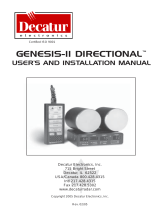
TABLE OF CONTENTS
INTRODUCTION .................................................................................................................................................................................. 1
INSTALLATION IS THE KEY TO PERFORMANCE ............................................................................................................................ 1
WATCH STALKER VIDEOS ONLINE .................................................................................................................................................. 2
Stalker Installation video .............................................................................................................................................................................................. 2
Using Your Stalker 2X video ........................................................................................................................................................................................ 2
AVOIDING FAN NOISE........................................................................................................................................................................ 3
HOW TRAFFIC RADAR WORKS ........................................................................................................................................................ 4
REAR TRAFFIC ALERT ....................................................................................................................................................................... 5
ABOUT TARGET ZONES .................................................................................................................................................................... 5
SETTING UP THE STALKER 2X ......................................................................................................................................................... 6
DISPLAY OPERATION ........................................................................................................................................................................ 7
Display Front Panel ..................................................................................................................................................................................................... 7
Display Unit Functions ................................................................................................................................................................................................. 7
LED Icon Indicator Definition ....................................................................................................................................................................................... 7
Arrow Indicator Definition ............................................................................................................................................................................................ 8
Display Messages (Shown in LED Window) ............................................................................................................................................................... 8
WATERPROOF DISPLAY OPERATION .............................................................................................................................................. 9
Waterproof Display Front Panel .................................................................................................................................................................................. 9
Waterproof Display Unit Functions .............................................................................................................................................................................. 9
LED Icon Indicator Definition ..................................................................................................................................................................................... 10
Arrow Indicator Definition .......................................................................................................................................................................................... 10
Display Messages (Shown in LED Window) ............................................................................................................................................................. 10
FAST-LOCK REMOTE CONTROL USAGE ....................................................................................................................................... 12
Remote Control Keys:................................................................................................................................................................................................ 12
INSTANT-ON REMOTE CONTROL USAGE ..................................................................................................................................... 15
Remote Control Keys:................................................................................................................................................................................................ 15
WATERPROOF FAST-LOCK REMOTE CONTROL USAGE ............................................................................................................ 18
Remote Control Keys:................................................................................................................................................................................................ 18
SETTING UP AND OPERATING THE DSR 2X ................................................................................................................................. 21
Faster Target Display On / Off ................................................................................................................................................................................... 21
Opposite Lane Sensitivity (Range) Adjustment ......................................................................................................................................................... 21
Same Lane Sensitivity (Range) Adjustment .............................................................................................................................................................. 21
Audio Squelch ON / OFF ........................................................................................................................................................................................... 21
Low-End Patrol Speed Selection ............................................................................................................................................................................... 22
Stopwatch Mode ON / OFF ....................................................................................................................................................................................... 22
Alert Closing Speed Selection ................................................................................................................................................................................... 22
Number of Antennas Selection .................................................................................................................................................................................. 22
ADJUSTING THE 2X ......................................................................................................................................................................... 23
Doppler Audio ............................................................................................................................................................................................................ 23
Beep Tones ............................................................................................................................................................................................................... 23
Voice Enunciator........................................................................................................................................................................................................ 23
Display Lighting ......................................................................................................................................................................................................... 24
Patrol Speed Blanking ............................................................................................................................................................................................... 24
Software Version ....................................................................................................................................................................................................... 25
Transmitter Frequency............................................................................................................................................................................................... 25
SETTING THE FOUR TARGET ZONES ............................................................................................................................................ 25
STATIONARY TARGET ZONE SETTINGS ....................................................................................................................................... 26
OPP/SAME STATIONARY MODE ..................................................................................................................................................... 26
MOVING TARGET ZONE SETTINGS................................................................................................................................................ 27
THE HOW AND WHY OF PATROL SPEED SHADOWING ............................................................................................................... 28
USING THE STOPWATCH MODE .................................................................................................................................................... 28
HOW FASTER SPEED TRACKING HELPS THE PATROL OFFICER .............................................................................................. 30
Moving Mode Example: ............................................................................................................................................................................................. 30
Stationary Mode Example: ........................................................................................................................................................................................ 30
INTERFERENCE SOURCES AND REMEDIES ................................................................................................................................. 31
Interference From Other Transmitters ....................................................................................................................................................................... 32
Low Supply Voltage ................................................................................................................................................................................................... 32
No Power ................................................................................................................................................................................................................... 32
WHY TESTING IS IMPORTANT ........................................................................................................................................................ 32
HOW TO INITIATE A SELF-TEST ..................................................................................................................................................... 33
TUNING FORK TESTING .................................................................................................................................................................. 35
Stationary Mode Tuning Fork Test ............................................................................................................................................................................ 35
Opposite Lane Moving Mode Tuning Fork Test ........................................................................................................................................................ 36
Same Lane Moving Mode Tuning Fork Test ............................................................................................................................................................. 37
DIRECTIONAL MOVING-VEHICLE TEST ......................................................................................................................................... 38
THE PERFECT PATROL SPEED WITH VSS .................................................................................................................................... 39
The CAN/VSS Solution – VSS Advantages without VSS installation problems. ....................................................................................................... 39
The VSS Speedometer Signal ................................................................................................................................................................................... 39
SPEED RADAR AND THE LAW ........................................................................................................................................................ 41
FCC Requirements .................................................................................................................................................................................................... 41
Case Law ................................................................................................................................................................................................................... 41























